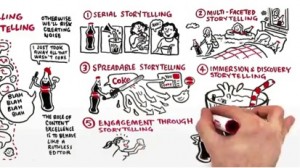 Once upon a time, there was a company that heard amazing, touching stories from its customers each day. These stories included sharing the news of a birth or sending love to a solider half-way across the world. The trouble was, these stories didn’t fit with the brand message. As time went on, executives would share these stories internally, but they were like warm notes only sent to close family and friends. The rest of the world didn’t get to see these stories very often. The leadership feared sharing the stories would remove the authenticity of the moments captured by their customers. So the stories were hidden away.
Once upon a time, there was a company that heard amazing, touching stories from its customers each day. These stories included sharing the news of a birth or sending love to a solider half-way across the world. The trouble was, these stories didn’t fit with the brand message. As time went on, executives would share these stories internally, but they were like warm notes only sent to close family and friends. The rest of the world didn’t get to see these stories very often. The leadership feared sharing the stories would remove the authenticity of the moments captured by their customers. So the stories were hidden away.
Some time after, the customers began ask, “Why should I come back to you? We have no relationship. You don’t even listen to my stories…” And the company began to wonder, did we miss something by hiding these stories?
You could pick a number of companies that have hit this point: marketing follows the brand message too closely, and they stop listening to the customer. Some companies try to handle this kind of change by including a dual marketing strategy, such as Allstate. Or other change their approach entirely, shifting to a new kind of marketing like Coca-Cola’s 2020 content strategy.
The point here is that no matter your company, you have to listen. Listen to find out if you are doing well. Listen to find out what you missed. Listen for the stories.
Stories are valuable things. We’ve used fables to teach and narratives to brainstorm. When there isn’t a story, we become numb to the information. Think of the difference between an evening newscast and the movie Act of Valor. The storytelling ends up making the movie feel more realistic than the newscast.
The pity in B2B marketing is that stories no longer excite or move. The formula for a case study (challenge, response, results) doesn’t transform you to sit in the manager’s seat and struggle with the same demands that the client in the case study faced. There is a place for the facts, but there has to be something more.
If you have an opportunity to hear stories from customers or clients, use them. Find ways to maintain the authentic voice, but share those stories. As you evolve over time, integrate those stories into your brand. Users have much more impact on brand identities today, so incorporate the user perspective. How can you share your stories?
- Create a stories portal with videos and letters directly from the customer
- Capture chapters of a story to share over time like a series
- Reach back and find stories from your company’s history that helped make you the company you are today
- Photograph events and interactions, collecting moments in pictures
- Use Pinterest’s boards as storyboards
As consumers continue to demand authenticity, you can’t ignore the power of stories. Use the insight from your customers instead of trying to fabricate what doesn’t exist. Incorporate the search and telling of stories into your marketing strategy, the same way you would advertising spend or website management. Then your storytelling will spill over into your employer branding and company culture. Make the story part of your company identity.
Then start listening for the stories of your stories…
What companies do you think do storytelling well? Which ones lose authenticity? What are your favorite company stories?
See how Coca-Cola has shifted its content strategy to include storytelling.







